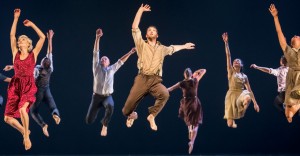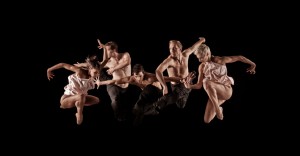The house was packed. The second-ever dance company to perform at the cushy new Wallis Annenberg Center for the Performing Arts in Beverly Hills, Les Ballets Jazz de Montréal easily sold out its two-night run (January 10-11 2014), and was welcomed by a good faith audience, comfortable and ready to cheer. The program had strong local ties, with the eagerly anticipated West Coast premiere of “Harry” (2013) by the remarkable L.A.- and Tel-Aviv-based choreographer Barak Marshall, as well as a staging of “Closer,” a sensual, crowd-pleasing 2006 duet by choreographer/director Benjamin Millepied (founder of the advancing L.A. Dance Project, and director-designate of Paris Opera Ballet, in fall 2014.)
Annenberg Center executive director Lou Moore opened the evening by bringing out BJM artistic director Louis Robitaille, a former dancer with Les Grands Ballets Canadiens who has run Ballets Jazz since 1998 — and still looks ready to nail a double pirouette. (One wonders: Does Moore believe all dance programming here requires some kind of verbal introduction? She asked the Graham company to bring a lecture-demonstration program when they performed this fall. )
Speaking with Moore in thickly accented English, Robitaille gleefully compared his commissioning of new works as when one “hires an architect” to design a home: he asks for a certain structure, with a combination of determined elements, and specifies a distinct style. With “Night Box,” a 2012 commission from China-born choreographer Wen Wei Wang, also on the evening’s program, Robitaille said he sought something “urban” and “modern.” From Marshall, whom Robitaille was quite effusive about (“I found him on You Tubes!”) he asked: “Bring some human kind…show us some women and men.” And of the Millepied piece, which was not a BJM commission, he mentioned the company’s luck of having French-born ballerina Céline Cassone — on whom Millepied originally created the work — performing the role with the troupe now.
Indeed, Cassone’s performance in Millepied’s “Closer,” which opened the bill, rang the clearest theatrical note of the evening. With her sinewy, weightless frame clothed in a filmy white tank top and panties, Cassone’s muscular flesh was a striking sight in this swirling duet set to Philip Glass’ “Mad Rush.” Partnered beautifully by Alexander Hille (wearing handsomely slouched street clothes), Cassone shot through the air, dropping and soaring through split-second elevation changes, her long, scissoring legs both propelling and braking her. Extended legs and feet were everything in this piece; Millepied used barely any arm gestures, barring a soft, low responsiveness as the bodies were moving. Thus the powerful shift in the third section when Hille tugged Cassone across the stage by her shoulder — he might as well have been clutching her heart or throat — her arms had been such a privately held area til then. That intimacy doubled again when the pair dove to the floor, and later wove and rewove their legs into a tightening clench. Aided tremendously by the heartening Glass score, this was surely the most creative and coherent Millepied choreography I’ve seen to date.
After a brief pause, Wen Wei Wang’s “Night Box,” a frenetic ensemble piece, quickly broke the evening’s spell. Set on a darkened stage, to monochromatic club beats and an opening montage of Montreal night scenes, it read like a hip commercial travelogue, then descended quickly into ubiquitous scenes of struggle — the kind of obtuse, twitchy, wrestling duets and trios that dominate much of contemporary partnered dance. The most pernicious problem was the seeping effect of this programming selection on the whole evening. “Night Box” was not just uninteresting, it made for a distorted, destructive echoing of Millepied’s “Closer,” (with Cassone again the grand belle, and another round of lower body-driven phrases, and even a repeat of the panty/tank top outfits) and, even more disastrously, its 35 minute-length created such a saturation of twisty leggy-ness it feels in some way responsible for what happened next to “Harry.”
Maybe the unseasoned dancers were more to blame (there are 6 new company members in BJM this season, and the unison work is very smudgy), yet I couldn’t help but feel like the relentless chill of “Night Box” (on top of “Closer”) somehow contributed to the odd way that Barak Marshall’s tribe of hot, arguing, bent-kneed people in “Harry” came off looking so ‘other’ when they took the stage. Marshall’s thrashing full-body gestures read almost spoofishly here, like Groucho Marx with his flapping hand and excited stage-gobbling walk. It was also hard to affix to particular characters because so many of the company members share similar characteristics (newcomer Kiera Hill stands out for her beautiful weightedness). And one more time, Cassone was the principal female — a real head-spinning casting decision, asking us to reckon her haughty lioness stature with the role of Marshall’s blushing, hyperactive, chosen village-girl.
Though “Harry” landed with a bad wobble, it is quite a fascinating piece, and I’m longing to see it done well (local L.A. company Body Traffic presents Marshall’s work with elan). Marshall’s narrative structuring is always deft, powerful, and surprising and this 40-minute work about one passive, genial young man who “refused to accept his fate” is a fast-flipping storybook tale of love vs. war, chaos vs. destiny. Domestic, biblical, ideological, mythological, verbal, physical — there is every kind of male-female sparring here, from scenes of young village girls insistently trying to make their ill-sized pot lids fit atop Harry’s cozy soup kettle to hopeful lovers felled by popped red balloons that spew smoke.
That there is no harmony between the sexes here, the men and women are both belligerent, whether on the battlefield or off, makes an important point. Instead of the ubiquitous clotted contemporary-dance struggling, Marshall’s dancers engage in real fights — yelling, spitting, ganging up, inciting wide-scale battles (we see Hera whimpering to Zeus, “Can you start a war for me, please?”) Yet when they group assembles in unison — in scenes of rollicking freeze-frame arm gestures and body twists — they are all telling the same story, asking the same questions, each with plenty of space to move. Some moments need better editing and balance: each of the recurring argumentative dialogues about rationality and faith, set funeral-side, are too long and too inditing of the female character. Yet the relentless relationship disharmony still makes a powerful point: in good love, each person has the freedom to hold a unique opinion. Contrast that with the climactic super-charged battlefield scene — drawn deftly with a single flag prop that evokes both the thumping death figure in Kurt Jooss’ “Green Table” and the iconic cluster of soldiers in the Iwo Jima Memorial — where any independent figure, any distinctly different action, puts anyone — even our good Harry — at terrible risk.

